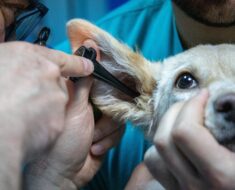Our furry companions curl up beside us, breathing softly, paws twitching as if in mid-pursuit. Are they dreaming? In the mysterious world of canine slumber, the answer is a resounding yes! While we can’t peek into their minds, science offers fascinating clues about what might be happening inside a dreaming dog’s head.
The Science of Dog Dreams:
Just like humans, dogs experience REM (Rapid Eye Movement) sleep, the stage where dreaming occurs most vividly. During this phase, their brain waves become similar to ours, and their muscles become temporarily paralyzed to prevent them from acting out their dreams. But unlike humans, dogs spend a larger portion of their sleep in REM, suggesting they dream more frequently, though for shorter durations.
What Do Dogs Dream About?
While we can’t ask them directly, observations and studies provide some hints. Small breed dogs, with faster metabolisms, are thought to have more frequent, shorter dreams, while larger breeds might have fewer, longer ones. The content of their dreams likely reflects their daily experiences, desires, and fears. So, a dog who loves chasing squirrels might have dreams filled with furry escapades, while a dog who gets anxious during walks might dream of scary encounters.
Signs Your Dog is Dreaming:
Pay attention to your pup’s slumber for these telltale signs:
- Twitching paws and legs: This could indicate running, digging, or chasing in their dreams.
- Eyelid fluttering: Similar to humans, dogs’ eyes move behind closed lids during REM sleep.
- Whining, growling, or barking: These vocalizations might be part of the dream narrative.
- Muscle twitches: Sudden twitches or body tremors could be reactions to dream events.
Should You Wake a Dreaming Dog?
Generally, it’s best to let your dog sleep undisturbed. Waking them abruptly from REM sleep can be disorienting, just like for humans. However, if their movements seem particularly violent or distressed, you can gently nudge or call their name to bring them out of the dream gradually.
The Bottom Line:
While the exact nature of dog dreams remains a mystery, the evidence suggests they are rich and complex experiences. By understanding the science and observing their behavior, we can gain a deeper appreciation for the inner world of our canine companions, even when they’re lost in their slumbering adventures. So next time you see your dog twitching and whimpering in their sleep, smile and know they’re probably having the time of their life, chasing squirrels or playing fetch in their doggy dreamscape.





